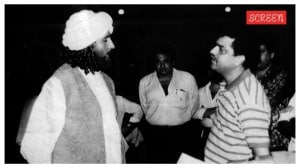It wasn’t too long ago that the so-called road from Jarang on National Highway-57 (connecting Muzaffarpur to Purnea) to Katara was more ‘boatable’ than motorable. For 7-8 months of the years, when much of this 22-km stretch was submerged, the journey through it actually entailed riding on small boats. But two developments in the last five years have helped bring Katara, a low-lying block town of Muzaffarpur, ‘closer’ to its district headquarters barely 40 km away via Jarang. The first was an embankment on the Bagmati River, preventing its waters from inundating large areas between Katara and NH-57. The second is a cluster of roads built under PMGSY.
Both together have made it possible for those living in Katara to really connect to other parts of Bihar. As the likelihood of inundation has reduced and boatable roads have given way to motorable roads, agriculture, too, has received a boost, with farmers being able to grow and market two crops — paddy and wheat — in a year, as against hardly one previously. Alongside, it has also led to the development of a hitherto non-existent land market. A katha (1,361 square feet or 0.03 acres) of land within a km of the NH-57 highway in the area today costs Rs 3-4 lakh.

But it’s not just Katara’s residents who have benefited. The shiny 7.3-km PMGSY stretch from Jarang to Bhusra Path — there’s another road connecting the latter further to Katara — runs through Asiya, Loma, Kamarathu, Jaya and Chorniya. They are all villages that have undergone transformation from ‘islands’ to ‘mainlands’ ever since this road, built at a height of 5-6 feet to avoid submergence came up. Costing Rs 40 lakh, its construction began on May 30, 2010 and was completed on November 9, 2011 well within the stipulated deadline. As per the tender agreement, the construction firm is obliged to also maintain the 7.3-km road for five years — which ends this November.
[related-post]
Story continues below this ad
When asked what difference the road has made, Uddan Sahni stops his bicycle to show the aluminium container tied to the carrier. It has katla and rohu from the pokhar (pond) near his village of Asiya. Earlier, the 55-year-old could sell this freshwater fish only in and around Asiya. But connectivity to Jarang has enabled him to sell the same fish — cheaper to catch from the pokhar than procuring at market rate — in villages along NH-57. Sahni now earns Rs 500 per day, double what it was previously. “Bhala ho pradhanmantri gramin sadak ka (blessed be PMGSY)”, he declares.
Sahni isn’t alone. Vinod Kumar Thakur, who tills two bighas (40 kathas or 1.25 acres), recalls the floods of 2007 – how these had converted the fields in Asiya into virtual ponds for months together. “Earlier, we just had a kutcha brick soling road, which itself would be under water. But with the PMGSY road that has been built at a height and also the embankment, we can easily take two crops. For the last many years, we were simply leaving our fields fallow”, he says.
According to Ram Pravesh Singh of Berwa village, a major benefit from the PMGSY roads, extending from Katara all the way to villages adjoining NH-57, is the improved access they have provided to schools and colleges. Many young students have bought motor bikes to go to colleges, while girls are riding bicycles to high schools.”There’s no better feeling than getting linked. Previously, we were looked down upon and it wasn’t easy to find marriage alliances for our boys. But the Bagmati embankment and the network of roads have suddenly changed people’s perception: They at least consider us as being from the civilised world”, he states.
If Katara is a story of people ‘rising above water’, the 6.82-km-long PMGSY road from Rajganj to Nathpur in Narpatganj block of Araria district is a tale of taking connectivity right to the Nepal border. Though still to be fully built, the locals have kind words about it, compared to the situation of wading through a muddy and dusty track only two years back. The Rs 4.52-crore project, on which work started on March 1, 2014, was to be completed by February 28 last year. But the leveled, even if not concretised, road itself has given people reason to cheer, because there is at least reasonable connection now between the Nathpur border and Narpatganj block town on NH-57.
Story continues below this ad
“It isn’t about the small distance of 7 km, but about access to the 15-odd villages along the route. The earlier road was full of pits and only tractors could ply on it. No block development officer or circle official would ever venture into villages here”, notes Ramji Paswan, a farmer from Nathpur.
Pankaj Kumar, who belongs to the same village, is not happy with the slow pace of construction. But he agrees that even a leveled mortar road today makes it easier to reach Narpatganj, from where there is a relatively smooth ride all the way to Patna. The number of motorcycles in his area has gone up five times in the last two years, he adds.
For Tarachand Paswan, 60, the journey from Nathpur was previously about bullock cart rides, with Narpatganj seeming like a ‘distant town’. He recollects how difficult it was to bring a car to the village and “we often had to cut the mud boundaries of our field to allow any VIP to reach us”. That has changed and “there are four-wheelers, too, in our village now”.
The most emphatic point is made by Laddu Bhagat, a local journalist: “The cluster under PMGSY has made our job of doing spot reporting from far-flung villages easier”. That is something one cannot possibly deny.

 This road has helped Uddan Sahni market his fish better. (Express Photo: Prashant Ravi)
This road has helped Uddan Sahni market his fish better. (Express Photo: Prashant Ravi)






